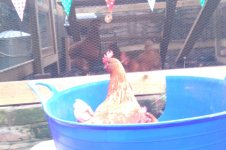You are using an out of date browser. It may not display this or other websites correctly.
You should upgrade or use an alternative browser.
You should upgrade or use an alternative browser.
Girls day out
- Thread starter rick
- Start date
rick
Active member
I think he might be out numbered! But yes, so different from our own perception it seems almost alien (but mammals are actually the oddball survivors it seems)
chrismahon
Well-known member
Of course the original jungle fowl lived in deep shade, so basically a very dark environment, and evolved to adapt to it.
I am of the opinion that they can certainly see the colour spectrum as we do. Why else would our cock Chester attack the bucket I poo pick with when it was changed to purple from the usual blue? Why would they sound the alarm call when I arrived for the first time in the enclosure wearing an orange shirt instead of a white or green one? Perhaps they can see both pictures at the same time- heat and light?
I am of the opinion that they can certainly see the colour spectrum as we do. Why else would our cock Chester attack the bucket I poo pick with when it was changed to purple from the usual blue? Why would they sound the alarm call when I arrived for the first time in the enclosure wearing an orange shirt instead of a white or green one? Perhaps they can see both pictures at the same time- heat and light?
rick
Active member
Sorry all, I'm a bit of a geek when it comes to physics and am greatly enjoying this insight into chicken senses. It doesn't change anything and I certainly don't know best but this is how I understand what I've read:
Although chickens inhabit woodland fringes in the wild, they (or their ancestors) evolved before the great extinction. Mammals survived that time, but only just and as a very narrow group of early, small animals that specialised in night vision (to take advantage of safer nocturnal living.) The chicken line never went through that 'bottleneck' in evolution and never developed the predominantly monotone rod based retina. That is why they are pretty much helpless in the dark.
They have excellent colour vision using a much higher density of red, green, blue cone cells in their retina than we have but also with adaptations that we never evolved like double cone formations and oil droplet filters that act like colour enhancing glasses! Some birds even have adaptations that polarise light and ones that enable them to see magnetic fields! (but not chickens)
As well as red, green and blue, chickens have cone cells that detect near Ultra Violet light (the other end of the spectrum from Infrared of night goggle fame.) UV light is the stuff that makes your tea-shirt and teeth florescent in the night club. Different matirials reflect UV light in ways that humans would never notice but synthetic materials are often highly reflective to UV though they may appear dull in what we think of as the visible spectrum.
Polymer coatings would generally reflect strongly and natural seed coatings would be in this group so it's not surprising that a chicken can pick all the millet out of the same colour mash. The millet is shining brightly!
Grass in sunshine would look purple to a chicken and what colour your orange jacket actually appears would be anyone's guess!
It's just so fascinating, I think, and helps to explain a whole load of apparently whacky behaviour.
They can see colours alright, but much better than we do and in a way that's hard to imagine!
I even found papers about their retinas being arranged in a way that was a previously undefined state of matter to science - clever girls
Just one other thing that's interesting (then I'll give it a rest!)
They have an optical 'frame rate' twice our own (about 100 cycles per second) which enables them to see the fine movement of predators amongst other things. But that also means our house lighting could be very annoying (like a flickering florescent light.) Particularly bad would be florescent tubes and 'low energy' LED lighting. We can just about see these effects if we move our head quickly. To a chicken it will be like a disco!
Although chickens inhabit woodland fringes in the wild, they (or their ancestors) evolved before the great extinction. Mammals survived that time, but only just and as a very narrow group of early, small animals that specialised in night vision (to take advantage of safer nocturnal living.) The chicken line never went through that 'bottleneck' in evolution and never developed the predominantly monotone rod based retina. That is why they are pretty much helpless in the dark.
They have excellent colour vision using a much higher density of red, green, blue cone cells in their retina than we have but also with adaptations that we never evolved like double cone formations and oil droplet filters that act like colour enhancing glasses! Some birds even have adaptations that polarise light and ones that enable them to see magnetic fields! (but not chickens)
As well as red, green and blue, chickens have cone cells that detect near Ultra Violet light (the other end of the spectrum from Infrared of night goggle fame.) UV light is the stuff that makes your tea-shirt and teeth florescent in the night club. Different matirials reflect UV light in ways that humans would never notice but synthetic materials are often highly reflective to UV though they may appear dull in what we think of as the visible spectrum.
Polymer coatings would generally reflect strongly and natural seed coatings would be in this group so it's not surprising that a chicken can pick all the millet out of the same colour mash. The millet is shining brightly!
Grass in sunshine would look purple to a chicken and what colour your orange jacket actually appears would be anyone's guess!
It's just so fascinating, I think, and helps to explain a whole load of apparently whacky behaviour.
They can see colours alright, but much better than we do and in a way that's hard to imagine!
I even found papers about their retinas being arranged in a way that was a previously undefined state of matter to science - clever girls
Just one other thing that's interesting (then I'll give it a rest!)
They have an optical 'frame rate' twice our own (about 100 cycles per second) which enables them to see the fine movement of predators amongst other things. But that also means our house lighting could be very annoying (like a flickering florescent light.) Particularly bad would be florescent tubes and 'low energy' LED lighting. We can just about see these effects if we move our head quickly. To a chicken it will be like a disco!
chrismahon
Well-known member
Not sure that the LED lights flicker Rick, but I'm sure the energy saving miniature florescent bulbs do. Fortunately the lights in our kitchen where Bottom sleeps are halogens, so he should be fine with those. Certainly something we need to be mindful of in future. My 'no batteries' calculator won't work under energy saving bulbs, so a lot of the spectrum is missing as well and that may affect chickens.
rick
Active member
Chickens can probably see a softened hum from household incandescent lighting (like halogen and standard bulbs) - softened by the time taken for the filament to heat and cool. Oddly enough, compact florescent lighting should be switching at somewhere between 10 and 20 KHz, way above what they can see but that's when they are working properly and all florescent lighting is subject to cathode wear that can produce some annoying effects.
It's difficult to know by looking what's actually going on with LEDs. Unlike florescents, efficient designs don't rely on a high frequency but their energy consumption can be improved by imposing a 'duty cycle' that is faster than the human eye can detect. They could be switching sharply at 75Hz and you wouldn't know without referring to the manufactures specification. Switching tends to be used to prolong battery life and, like you say, my house lighting LEDs do appear to be pretty smooth. If LEDs are switching under 100Hz then, because their on/off transition is very sharp, you should be able to see it by viewing the light in a hand mirror and wobbling the mirror around.
Unfortunately, the quality (spectrum) of all artificial light is pretty poor compared to sunlight and LEDs are still the worst.
It's difficult to know by looking what's actually going on with LEDs. Unlike florescents, efficient designs don't rely on a high frequency but their energy consumption can be improved by imposing a 'duty cycle' that is faster than the human eye can detect. They could be switching sharply at 75Hz and you wouldn't know without referring to the manufactures specification. Switching tends to be used to prolong battery life and, like you say, my house lighting LEDs do appear to be pretty smooth. If LEDs are switching under 100Hz then, because their on/off transition is very sharp, you should be able to see it by viewing the light in a hand mirror and wobbling the mirror around.
Unfortunately, the quality (spectrum) of all artificial light is pretty poor compared to sunlight and LEDs are still the worst.
rick
Active member
I've given up on the idea of taking the girls to the allotment, at least for now. It's just too much of a mission and though it would be interesting to see what they make of it I've had to weed in the meanwhile and there's little left to do.
I have turned over the mulch from the coop with the mulch that has been on the open ground for a month and it was so full of worms, millipedes and the like they had a busy afternoon spreading it around the run (I just dumped it in a big pile in the middle and within an hour it was nicely spread all over!)
I have turned over the mulch from the coop with the mulch that has been on the open ground for a month and it was so full of worms, millipedes and the like they had a busy afternoon spreading it around the run (I just dumped it in a big pile in the middle and within an hour it was nicely spread all over!)
valeriebutterley
New member
When I watch what goes in through the beak, it never fails to surprise me how yummy my girls' eggs are!
I just try not to think about it - I also try not to remember the 'shared exit route.'
valeriebutterley
New member
Completely forgotten about that, YUK!!!!!!!!!!!!!!!!!!!!!
chickenfan
Active member
- Joined
- Mar 9, 2013
- Messages
- 1,049
- Reaction score
- 0
So sorry after all these posts that the girls never had their day out - I was looking forward to hearing how it went!
rick
Active member
Your right Chickenfan! If it's not raining at the weekend I'm going to pick a couple of space cadets and go for it!
rick
Active member
Teabag and Blaze volunteered to boldly go...
The Galus I module ready for launch (also serves as a dust bath)

Arrival on planet allotment

The landing site

Fun finding strange new life forms (and eating them)

Site thoroughly explored and ready for the return journey. Teabag aborts lift off 3 times by escaping the vehicle.

Splashdown and welcoming committee.

Debriefing: Overall they seemed to enjoy it and were not keen to leave. They obviously weren’t keen on the transport part but they were not panting at either end so I don’t think it was too stressful. It was about 10 mins in the tub from end to end. Seeing as they spent the whole time scratching and eating was surprised that they seemed to be ravenous on return and spent 5 mins tucking into crumble!
The Galus I module ready for launch (also serves as a dust bath)

Arrival on planet allotment

The landing site

Fun finding strange new life forms (and eating them)

Site thoroughly explored and ready for the return journey. Teabag aborts lift off 3 times by escaping the vehicle.

Splashdown and welcoming committee.

Debriefing: Overall they seemed to enjoy it and were not keen to leave. They obviously weren’t keen on the transport part but they were not panting at either end so I don’t think it was too stressful. It was about 10 mins in the tub from end to end. Seeing as they spent the whole time scratching and eating was surprised that they seemed to be ravenous on return and spent 5 mins tucking into crumble!
Wonderful! I bet they kept the others awake with their stories of a trip to a new planet!
rick
Active member
However... This morning, and for the first time, someone layed an egg whilst roosting. Luckily the sisters prefer to roost on the low perch. So if they go again it will be when I'm confident that they have laid for the day. Summer evening maybe.
valeriebutterley
New member
Rick,
loved it! Mine can only go to the bottom of the garden for a great adventure.
loved it! Mine can only go to the bottom of the garden for a great adventure.
chrismahon
Well-known member
Nice photos Rick. Are you sure they can breath in that bucket? Did you give them water whilst they were out? We have the occasional egg dropped off the perch by one of ours at night. We have lowered the perch and put a fusion of bedding underneath created by newspaper over an inch of wood shavings. Seems to work well and the only ones that crack have thin shells anyway -the newspaper soaks it up and is quickly changed.
rick
Active member
Hi Chris. Thanks, I took a load of photos and picked the most suitable to document the adventure.
The hessian over the top is a very open weave, practically netting. I took a fold up dog bowl and a bottle of water. There is water in baths on the allotment but it gets pretty green with algae so I packed some fresh.
I'm hoping the laying in the night will be a one off as the perch is low and its over bark chippings but the egg was sitting in a pile of poo! I really only provided a perch at floor level as they like to sit on it during the day and look out towards the house. Betty and Aerial roost on the front edge of the nesting shelf with the nesting boxes behind (and with less headroom in the nesting boxes which discourages them roosting that far back.) I have shavings on that shelf and it makes it much easier to poo pick in the morning.
Going to try to get them to all roost up there as it's going to be a warmer area in the winter.
What I'm thinking though is if a hen lays an egg at night she might stick to that 12 hour cycle? Or will she sync again with the rest of them? It's all a bit sporadic at the moment - Betty laid an egg outside on the ground last week and even Aerial (this year's hybrid) seems not to be laying every day.
The hessian over the top is a very open weave, practically netting. I took a fold up dog bowl and a bottle of water. There is water in baths on the allotment but it gets pretty green with algae so I packed some fresh.
I'm hoping the laying in the night will be a one off as the perch is low and its over bark chippings but the egg was sitting in a pile of poo! I really only provided a perch at floor level as they like to sit on it during the day and look out towards the house. Betty and Aerial roost on the front edge of the nesting shelf with the nesting boxes behind (and with less headroom in the nesting boxes which discourages them roosting that far back.) I have shavings on that shelf and it makes it much easier to poo pick in the morning.
Going to try to get them to all roost up there as it's going to be a warmer area in the winter.
What I'm thinking though is if a hen lays an egg at night she might stick to that 12 hour cycle? Or will she sync again with the rest of them? It's all a bit sporadic at the moment - Betty laid an egg outside on the ground last week and even Aerial (this year's hybrid) seems not to be laying every day.
chrismahon
Well-known member
We've got one out of synch- it's the release of the yolk from the ovary that triggers them to go to the nest box and if the previous egg isn't ready they will come out and lay it outside. It isn't a 12 hour cycle but 24 hours or more. All of ours run a bit later every day and miss the night so perhaps 26 hours plus. But they are all slowing down now and might be laying every other day, so lack of daylight must come into play, even though we get significantly more here than England, not just from the latitude but also the 180 degree uninterrupted sky aspect.
You will find that putting newspaper down is quicker and cheaper than shavings, so long as they don't dig it up!
You will find that putting newspaper down is quicker and cheaper than shavings, so long as they don't dig it up!
Latest posts
-
-
-
Topic Of The Week: Winter Egg Production: Challenges and Successes
- Latest: CherishedFowlGuardian
-
-
I recently lost my Lizzy. She couldn't walk for two years. I was her legs. Isn't she beautiful!
- Latest: CherishedFowlGuardian
-
-
-
